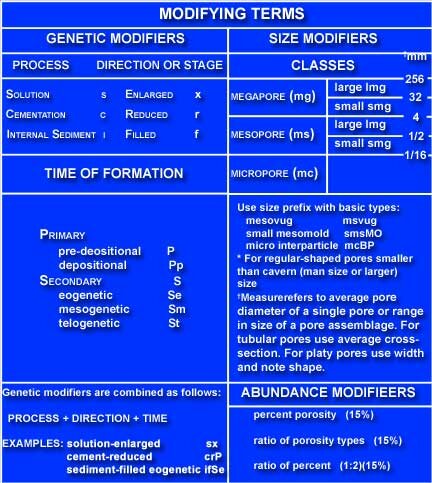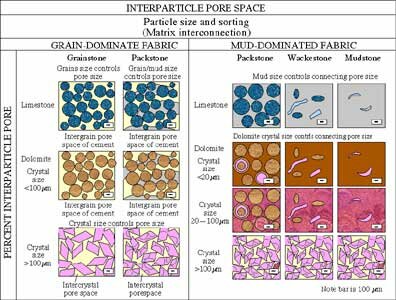|
It's all about porosity and permeability in the oil industry. Minute to large openings or passageways represent the storage tanks and pipelines. These are normally complex both physically and in terms of their origin. The distribution of pore space between nonporous grains (similar to the interparticle space of sandstones) represents geometry and genetic simplicity that is unusual in sedimentary carbonates. Carbonate porosity systems are as a rule far more complex than in siliciclastic sediments. Differences between the two sediment types originate largely because significant amounts of pore space are built into carbonate particles (intraparticle pores) or develop in response to diagenesis. Growth patterns riddle most skeletal particles with pore space. Even organisms that produce dense skeletons do so through the use of organic sheaths whose decay following the organism’s death create a network of internal micropores. Binding carbonate organisms construct additional pore space within their growth framework. Reef builders create large passages as a result of coalescing growth between adjacent reef builders. Finally, additional pore space complexity results from diagenesis.
The complexity and multiplicity of carbonate porosity posses severe reservoir characterization challenges. No one porosity classification scheme adequately characterizes carbonate pore space, so industry geoscientists use the Choquette and Pray (1970) classification to help categorize carbonate pore space for questions on how the pore systems evolved, and the Lucia (1995) or Lucia et al. (2001) classification to address reservoir rock performance issues.
|

Porosity classification after Choquette and Pray (1970)
|
|
Lucia (1995) Porosity Classification
This classification scheme is interested in dividing carbonate rocks into categories that reflect reservoir performance. Basically two textural parameters are exceptionally important: 1) whether or not grains form a self supporting framework, 2) grain size. Note that Lucia treats diagenetic products (i.e. dolomite crystals) and grains alike because the origin of the particles is irrelevant. This can become a bit tricky to apply in cases where the boundary between dolomite rhombs and replaced grain partially mimic one another. The guiding light is always porosity. If the pores are connected between the dolomite crystals, then the dolomite rhomb sizes are most important to consider. If not, then the original grains themselves prevail.
Mud-dominated rocks perform similarly in terms of flow because mud-size particles govern the connection between interparticle pores. It is for this reason that Lucia lumps Dunham's (1962) packstone, wackestone and mudstone into the same category. Please note that as originally defined Dunham (1962), packstone textures could have as little as 1+ % mud. Empirical data showed that packstone with 1-10% mud exhibits intermediate flow characteristics to those of grainstone and mud-dominated fabrics. Hence, Lucia (1995) called these fabrics grain-dominated packstone.
Please note that this classification only considers interparticle porosity. For a more comprehensive description of the petrophysical behavior of carbonates, non-interparticle porosity (molds, fenestral, vug, shelter, growth framework, etc.) must be considered. Lucia simplifies these additional pore types by putting them into separate and touching vug categories. This classification and its relationship to porosity and permeability is another topic discussed in our porosity-permeability training course.
|

Lucia (1995) interparticle porosity classification
|



